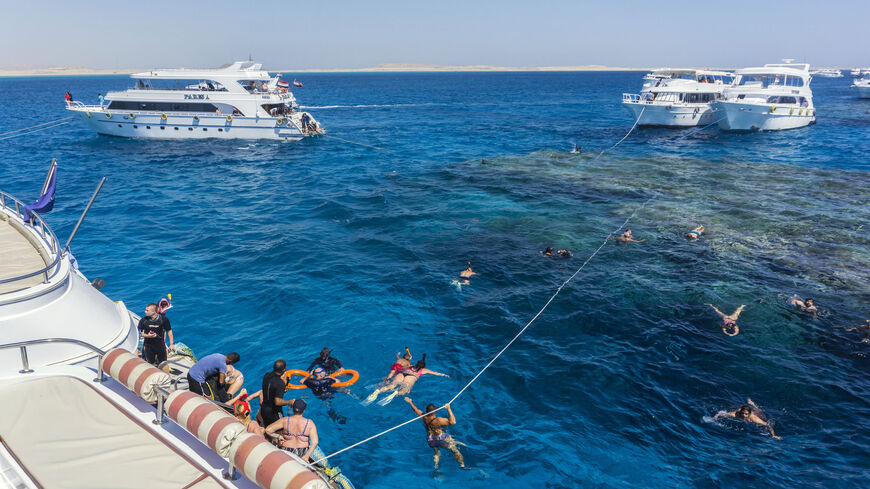Egypt is seeking to increase Arab tourism from the Gulf at a time when the vital tourism sector has struggled to overcome the setback it suffered with the Russian invasion of Ukraine.
The war that broke out between Russia and Ukraine in February has hindered the normal influx of tourists from the two countries, while they constituted about a third of the total number of tourists who flocked to Egypt annually.
Tourism, along with the revenues of the Suez Canal and the remittances of workers abroad, constitutes one of the main sources of foreign currency in the country, which has been weighed down by the pressure of the war in Ukraine on its economy, as it struggles with an unprecedented wave of inflation.
Egypt adopted harsh measures in an attempt to overcome the repercussions of the war, including the devaluation of the local currency by 15% in March. It also resorted to the International Monetary Fund to seek an emergency aid program to address the current economic crisis.
In late April, the Egyptian Ministry of Tourism launched a promotional campaign on social media — titled “Your vacation in Egypt” — to attract foreign visitors who are planning a summer vacation abroad.
The campaign mainly targets Arab markets exporting tourism to Egypt, including Saudi Arabia, the United Arab Emirates (UAE), Kuwait and Jordan.
Amr el-Kady, CEO of the General Authority for Tourism Activation affiliated with the Ministry of Tourism, said in a statement that the campaign also aims to revitalize domestic tourism.
Egypt had launched a similar campaign in March called “Follow the Sun,” to attract tourists from the United Kingdom, Germany, Italy, France and the United States.
Tourism officials in Egypt expect the war in Ukraine to hinder growth in the sector's revenues. Deputy Tourism Minister Ghada Shalaby said in an April 18 interview with Bloomberg that “expectations for Egyptian tourism in 2022 are not higher than last year,” without mentioning any estimates.
Shalaby noted that the government is looking to attract tourists from India, Pakistan, Morocco, Algeria and Gulf countries including Bahrain, Qatar and Kuwait.
Data published by the Ministry of Tourism in July 2021 indicate that about 20% of the tourists who used to visit Egypt before the coronavirus pandemic came from Arab countries. Saudi Arabia comes first, followed by Kuwait and the UAE.
In 2021, Egypt achieved tourism revenues that exceeded $13 billion, bringing back pre-pandemic levels, according to the ministry data.
Meanwhile, Minister of Tourism and Antiquities Khaled al-Anani had revealed in January 2021 that 3.5 million tourists brought in $4 billion of tourism revenues in 2020, marking a 70% decline from 2019, when tourism revenues reached $13.03 billion, with more than 13 million tourists visiting the country that year.
Magdy Salim, former official in the Ministry of Tourism, expects inbound tourism to Egypt to drop by 50% compared to 2021.
He told Al-Monitor over the phone that this percentage might still increase as the long-term effects of the coronavirus pandemic are still being felt.
Egypt was hoping that its tourism sector would be active this year, coinciding with the easing of COVID-19 restrictions in most countries. However, the Russian war on Ukraine has increased the burdens on tourism, which is one of the most important sources of national income for Egypt.
In 2019, Ukraine had the second-largest number of tourists visiting Egypt, accounting for 1.6 million visitors and recording an increase of 32% from 2018.
More than 727,000 Ukrainian tourists entered Egypt in 2020, according to the Ukrainian Embassy in Cairo, constituting 21% of the total number of foreign tourists who visited Egypt in that year.
According to the Ukrainian State Agency for Tourism, 1.46 million Ukrainians traveled to Egypt in 2021, making Egypt their second-most popular tourist destination after Turkey.
Salim noted that the tourism sector has been greatly affected by the suspension of incoming Ukrainian tourism, which has been growing significantly in recent years, ruling out the return of Ukrainian tourism in the foreseeable future to pre-war levels.
Meanwhile, Russia has always been at the forefront of the exporting markets for tourists to Egypt. Nearly 3 million Russian tourists visited Egypt in 2014, before Moscow imposed a ban on direct flights to Egyptian tourist destinations following the crash of a Russian charter plane upon takeoff from Sharm el-Sheikh in 2015, which killed all 224 people on board.
In July 2021, Russia lifted the ban on charter flights to and from Egypt. Since then, 700,000 Russians visited Egypt until the end of 2021, with 125,000 Russian tourists entering the country in the first two weeks of 2022, according to Russian Ambassador to Cairo Georgy Borisenko.
To revive inbound tourism, the Egyptian government started early April to implement a facilitation package for tourist visas allowing entry to the country. The package included, for the first time, granting foreigners coming to the country an emergency entry visa at the various arrival terminals, provided that they hold entry visas for Japan, Canada, Australia, New Zealand, the United States, the United Kingdom and the Schengen countries.
On March 22, the government also agreed to extend the charter flight stimulus program until the end of October. The program, which aims to support tourism, allows airlines to obtain cash incentives ranging from $1,500 to $3,500 per flight. It was supposed to end late April, but the program will now continue to operate until the end of October.
A source in the Ministry of Tourism told Al-Monitor on condition of anonymity that the tourism sector will not fully recover before 2025.
The source said that the ministry has a long-term plan to target new tourist markets, especially from Latin America and East Asia, with the increase in the volume of inbound tourism from the Gulf countries in an attempt to bridge the gap created by the Russian war and, before it, the coronavirus pandemic.
Egypt was one of the first countries to open its doors to tourists in July 2020 amid the implementation of strict precautionary measures in a desperate attempt to save the tourism sector, whose revenues dropped by about 70% during the same year due to the pandemic and the subsequent closure of tourist facilities and hotels, travel restrictions and lockdowns that affected the entire world.
The pandemic led to a decrease in the hotel occupancy rate in Egypt by about 60% in 2020, which caused losses of about $14 billion, according to Egyptian Finance Minister Mohamed Maait.
However, tourism workers hope that performance will gradually improve and that some losses will be compensated with the resumption of flights between Moscow and Cairo, after a short halt due to the war, in addition to limited flights between Russia and the Red Sea resorts.
Shalaby said the announcement of new international flights to Sharm el-Sheikh in the Red Sea could boost tourism revenues as well.
Egypt welcomed April 17 the first direct flight between Sharm el-Sheikh and Tel Aviv, as part of an agreement reached between Egyptian President Abdel Fattah al-Sisi and Israeli Prime Minister Naftali Bennett in March.
In early April, 300 Russian tourists arrived in Hurghada, the first arrival since the start of the Russian war on Ukraine.
Russian companies are also expected to increase the number of flights to Egypt, coinciding with the decision of authorities in Moscow to lift COVID-19 restrictions on regular and charter flights to 52 “friendly” countries, including Egypt.
In addition to the resorts in Sinai overlooking the Red Sea, which is famous for its coral reefs, Egypt is preparing to open the Grand Egyptian Museum in the last quarter of 2022. Egypt is relying on this 20 billion Egyptian pound (about $1 billion) project to revive the tourism sector, with more than 100,000 antiquities, including 5,000 pieces within the Tutankhamun collection, displayed at the museum.
“It is necessary to knock on all doors to revive tourism, which directly affects the 2 million people working in the sector,” Salim concluded.






